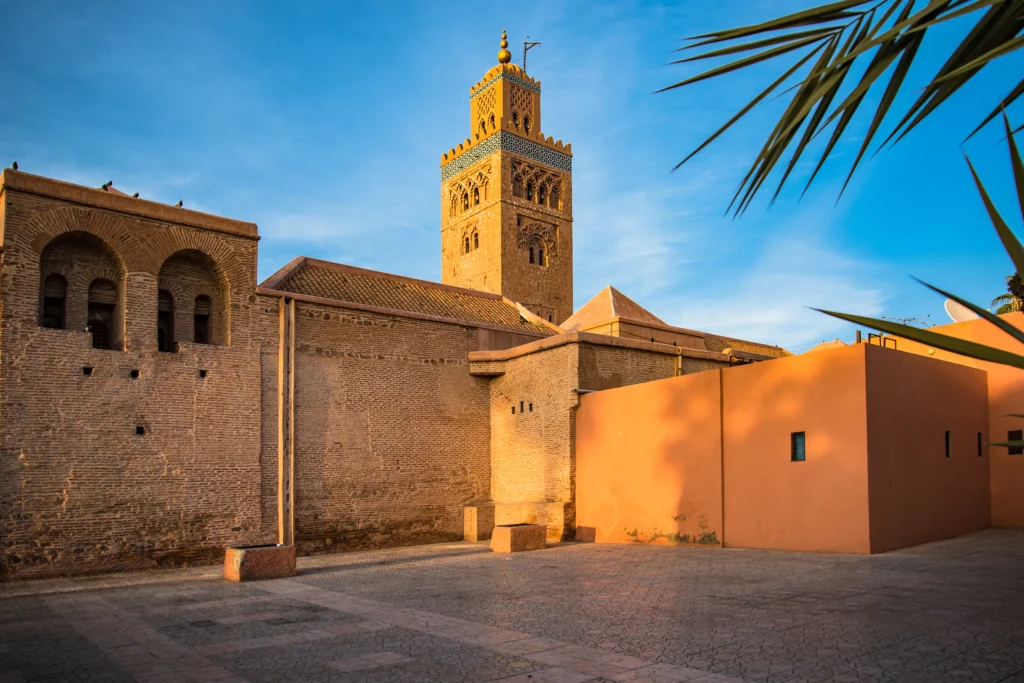Introduction to renovation projects in Marrakech
Marrakech, with its enchanting blend of centuries-old traditions and modern influences, has become a hotbed of innovation and creativity in the renovation field. This ochre city attracts not only tourists, but also designers, architects and lovers of art and history, eager to revive and revitalize old buildings. In this article, we'll explore why Marrakech is a hotbed for renovation projects. We'll also present some inspiring examples of renovations that embody the perfect harmony between past and present.
Why Marrakech is a renovation center
Marrakech's historical heritage
Marrakech, the imperial capital, has a rich historical heritage dating back over a thousand years. Its labyrinthine alleyways, lively souks and lush gardens bear witness to a fascinating history. Traditional structures such as riads and kasbahs are often silent witnesses to this glorious past. However, with the ravages of time, these buildings require skilful renovation to preserve their architectural integrity and authentic charm.
Attractive city for expatriates and designers
Over the years, Marrakech has attracted a growing community of expatriates and designers inspired by the city's cultural richness. This fusion of cultures and ideas has created an environment conducive to architectural innovation. Many designers are captivated by the opportunity to marry traditional elements with contemporary concepts, leading to groundbreaking renovation projects. Heritage preservation initiatives are often supported by international experts who bring with them modern techniques and visions.
Selection of five inspiring renovation projects
Project selection criteria
To determine the most inspiring renovation projects in Marrakech, several criteria were taken into account. Firstly, the visual and cultural impact of the project is essential, as it must make a significant contribution to the city's charm and heritage. Secondly, the innovations introduced during the renovation and the originality of the design also play a key role. Finally, the durability of the materials used and the respect for traditional techniques ensure that these renovations stand the test of time while honoring Marrakech's heritage.
First renovation project: The transformation of a traditional Riad
Description of the initial condition of the property
The renovation project for this traditional riad in Marrakech began with the initial state of a property which, although full of charm, was marked by obvious signs of ageing. Over time, refined architectural elements such as moucharabiehs and zelliges have suffered the ravages of climate and neglect. The walls, once vibrant with ochre and terracotta, were gradually fading. The marble slabs in the central courtyard needed urgent restoration to regain their former brilliance.
The Riad's history and architecture
Dating from the early 20th century, this riad is a striking example of traditional Moroccan architecture. Its generously dimensioned spaces, arranged around a verdant central courtyard, are adorned with detailed stucco work and chiselled wooden ceilings. The riad's architectural harmony is based on the subtle interplay between indoor and outdoor spaces, and a structure that encourages natural ventilation and light. However, the passage of time had eroded some of these distinctive elements, necessitating a renovation respectful of its history and architecture.
Challenges specific to Riad renovation
Transforming a traditional riad in Marrakech presents unique renovation challenges. One of the greatest challenges lies in preserving original architectural elements while incorporating modern updates for functionality and comfort. Preserving heritage features calls for local craftsmen skilled in traditional techniques, such as tadelakt restoration and the reconstruction of moucharabiehs. In addition, modernization of the water and electricity supply systems had to be carried out with care so as not to detract from the riad's authentic aesthetic.
Renovation details
Applied design approaches and strategies
In this renovation project, the design team's approach was to create a perfect balance between tradition and modernity. The plans involved restoring historic features using traditional techniques, such as the reconstitution of stucco and zellige by local craftsmen. To introduce contemporary elements, spaces were redesigned to infuse the riad with natural light, while high-quality, sustainable materials were subtly integrated. The interior design has been reimagined to maximize modern comfort while preserving the residence's historic charm.
Impact of renovation on property improvement
The riad's transformation has had a significant impact not only on the property itself, but also on its perception and enhancement within Marrakech's architectural landscape. Meticulous restoration has brought fascinating architectural details back to life, enriching the visual and sensory experience for occupants and visitors alike. The fusion of traditional and contemporary elements has resulted in a harmonious revitalization that exudes elegance and authenticity. In addition, upgraded facilities and infrastructure systems enhanced overall functionality, ensuring the building's longevity while honoring its historical legacy.
Second renovation project: Restoration of a Berber house
Context and objectives of the renovation project
The restoration of this typical Berber house, nestled in the Atlas Mountains near Marrakech, represents a major challenge for lovers of architectural heritage. The aim of the project was to revitalize the authenticity of a centuries-old building, while providing the modern comforts required for a contemporary home. Over the centuries, the house had suffered the ravages of the mountain climate and required special attention to preserve its distinctive features and reinforce its damaged structure.
Meaning and cultural values of the Berber house
Berber houses are much more than just dwellings; they embody the traditions, lifestyle and history of the Amazigh people. The original structure, often built in adobe, reflects a harmony with the surrounding landscape and testifies to the ingenious use of local resources. Preserving these houses means perpetuating ancestral know-how and keeping alive a priceless cultural heritage. Each renovation must respect the spirit of the place, while allowing future residents to live in comfort.
Customer needs and expectations
The customer, seduced by the authenticity and rustic simplicity of the Berber house, wanted to preserve its character while integrating modern conveniences. The vision was to create a space where the warmth of the traditional Berber fireplace would harmonize with discreet contemporary touches. Expectations included upgrading the thermal systems to cope with the harsh Atlas winters, while ensuring that the house remained a model of sustainable energy efficiency.
Renovation process and execution
Techniques and resources used in restoration
Restoration of the Berber house began with a careful study of its ageing structure, followed by consolidation of the adobe walls using modern stabilization techniques. The priority was to use local, environmentally-friendly materials to remain true to the original. The walls were plastered with tadelakt, a lime plaster traditionally used in Morocco, to enhance insulation while preserving the authentic textures. Local craftsmen lent a hand in restoring wooden details and decorative elements, inscribing their know-how into every finish.
Reinventing spaces and integrating modern comforts
To bring the house back to life, it was necessary to redefine the spaces. Rooms were redesigned to optimize natural light, essential in the Moroccan climate. Traditional heating systems such as the kanoun were restored and complemented by modern solutions such as solar panels subtly integrated into the roof. Communal living spaces have retained the convivial, communal spirit typical of Berber homes, while introducing modern amenities in bathrooms and kitchens for enhanced comfort.
Respect for architectural traditions combined with modern innovations has transformed the Berber house into a living space that honors its past while meeting the needs of the present. This renovation project is a testament to the richness and depth of Berber heritage, and to the possibility of preserving it in an ecologically and culturally responsible way. By bringing this house back to life, the project has not only revitalized a precious part of Morocco's cultural heritage, but has also created an inspiring model of sustainable renovation for other similar projects in the region.
Third renovation project: Renovating a modern villa in Marrakech
Conservation of modern architecture with a Moroccan touch
Architectural practices and materials used
The rehabilitation of this modern villa in Marrakech began with an analysis of its contemporary architecture, beautifully chiseled into the surrounding natural setting. The materials used, ranging from polished concrete to expansive glass, provided a solid foundation for the integration of distinctive Moroccan touches. The architects collaborated with local craftsmen to incorporate traditional elements such as tadelakt and zellige, while maintaining the villa's clean, minimalist design.
Integration of new technologies and home automation
The modernization of this villa was not limited to its exterior appearance. State-of-the-art home automation systems have been added to transform the villa into a true "connected home". Every detail, from lighting to energy management, is controlled at the click of a button, offering a practical and sustainable lifestyle. For complete, high-quality support in your renovation or construction projects in Marrakech, Life Smart Home offers recognized local expertise and tailor-made solutions.
Modernization of interior living spaces
Reconfiguration of living areas
To meet the needs of modern, dynamic living, the villa's spaces have been reconfigured to optimize fluidity and interior luminosity. Partitions have been reduced, allowing natural light to flood generously into every corner of the house. The main living areas, such as the lounge and dining room, have been designed to comfortably accommodate residents and their guests.
Creating harmonious outdoor spaces
The refurbishment didn't just concern the interior spaces. The garden was carefully landscaped to reflect both Moroccan aesthetics and modern sustainability standards. Shaded patios, green walls and infinity pools were integrated, creating an oasis of tranquility in Marrakech, perfect for relaxation and entertaining.
Sustainability and environmental impact
Use of renewable resources
In line with contemporary energy efficiency standards, the villa has been fitted with solar panels and a rainwater recovery system. These installations have significantly reduced the property's carbon footprint, making the entire renovation not only attractive but also environmentally friendly.
Enhancement and economic potential
This modernized villa represents not only an impressive example of renovation, but also an attractive investment in Marrakech. By incorporating cutting-edge technology and sustainable materials, the property has seen its value rise significantly, becoming a benchmark in the region's luxury real estate market.
FAQ
- What types of renovation projects are popular in Marrakech?Renovation projects in Marrakech often include the conversion of riads, the restoration of Berber houses and the refurbishment of modern villas.
- What materials are used in Marrakech renovations?Renovations use local, eco-friendly materials such as tadelakt, zellige and adobe, while integrating modern technologies such as home automation systems.
- Why is Marrakech such a popular place for renovation?Marrakech's cultural richness, unique historical heritage and influx of international designers make it a dynamic hub for renovation.
- How are renovation projects impacting the Marrakech real estate market?These projects increase property values, attract international investors and help preserve the city's architectural heritage.
- What are the current design trends for renovations in Marrakech?Current trends include the blending of traditional and contemporary styles, the integration of connected-home technologies and the use of sustainable materials.
Conclusion
Renovation in Marrakech is not just about restoring the old, but creating a perfect symbiosis of tradition and modernity. These inspiring projects demonstrate Marrakech's cultural richness while paving the way for exciting architectural innovations. If you're planning to renovate or build in Marrakech and would like excellent support, Life Smart Home offers a full range of personalized services to meet the most exacting standards. Don't hesitate to contact us for a quote, to view our completed projects or to make an appointment to discuss your vision. Marrakech and its opportunities await you.



 by
by